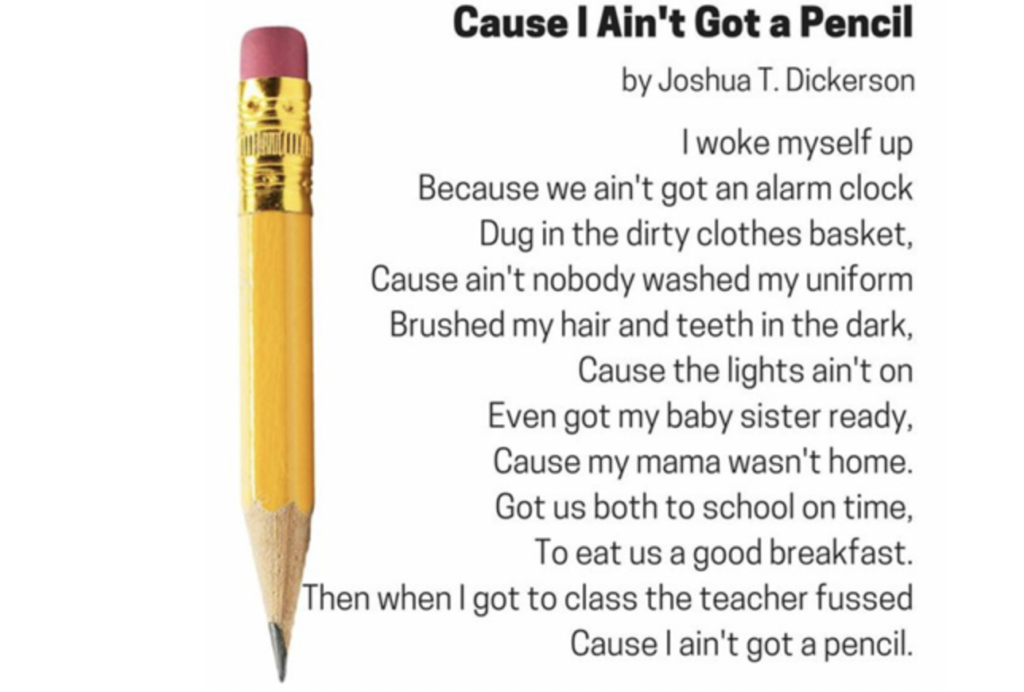
Oftentimes, it’s easy to forget that students are living entire lives outside of the classroom. Like the poem Cause I Ain’t Got A Pencil illustrates, there are a million factors and scenarios that students can live out before they come to your classroom that day. To you, the teacher, it looks as though this student walked into your classroom in a mood and started getting reactive: maybe refusing to do work, maybe yelling at other students–or you–and maybe even got violent–all for what seems like to you (the teacher) no reason.
We read in Social Studies in the 21st Century by Jack Zevin, that students are going through a myriad of social, emotional, physical, and intellectual changes. This, on top of a turbulent home life, could leave very little space in one’s brain for a ninety-minute class. The job of the teacher is to meet the student where they are and guide them to where they need to be. Or, if they’re already where they need to be and beyond, it’s the teacher’s job to rise to the student’s needs and challenge them academically. Either way, teachers need to be aware of their audience and adapt to each learner and their challenges or advantages. Zevin tells us, “Just as you will find yourself choosing among a number of instructional roles in a middle or high school, you will also be faced with learners who vary.” Students do not exist only in the classroom, and once teachers fully take that into account, the root of the problem, whether it be social or behavioral, can typically be identified. This is what Zevin means when he discusses knowing your audience and catering to your audience. By not thinking about the backgrounds of your students and what types of learners they are and by not taking into account their lives outside of your classroom, you are discouraging and potentially harming their academic performance.
Another thing that the readings touched on was that before you can truly know your audience, you must know yourself. In Historical Thinking by Sam Wineburg, we read about four different educators and how their different academic backgrounds could effect their personal lenses on how they teach history. Fred, the first example, was a political scientist who was admittedly “no fan of history” and chalked it up to being just facts, plain and simple. Whereas Jane, the history major, used the facts to form a narrative on the story of the past. Though this was just an example, I would personally argue that it goes farther than academics. Since I am from a family of immigrants, the narrative in which I would teach the history of immigration in America could potentially be different than the narrative that someone who is anti-immigration would construct.
Once you know yourself and you know your own biases, you can fully understand your audience and how they may behave when it comes to different subjects in history. In my first lesson plan on music during the Harlem Renaissance, I’m discussing how it changed the racial and social viewpoint at the time. Throughout the lesson I encourage students to relate the topic back to today’s society, and our last class discussion is on how music changed or influenced racial and social viewpoints at the time (ex. Strange Fruit by Billie Holiday), and by knowing my audience, during this discussion I’d be able to foster a discussion with minority students on how the oppression that was faced by Black America during this time has morphed into the oppression that they face today.

I love your thoughts on the readings! The poem you included was also very insightful and a nice touch. I loved the point on students not only existing in the classroom. That is why checking in on students is so important and remembering they are trying their best and that life can be difficult. I also believe it is so important to know yourself so you can fully know your audience and I think that is often overlooked in this profession.
I also love the point of students not only existing in the classroom. I used to get in a lot of trouble In school for round about effectively being too poor to have nice things or not being able to bring certain things to class. So it is very good of you to say something.